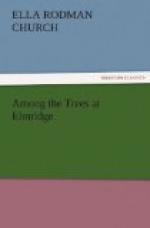[Illustration: IRISH JUNIPER.]
“Is that what our cedar-chests are made of to keep the moths from our winter clothes?” asked Clara.
“Yes,” replied Miss Harson, “but the name ‘cedar’ is; not correct, though it is one commonly given to this tree. The wood of the European cypress is also used for many purposes where strength and durability are required, for it really seems never to wear out. This tree is described as tapering and cone-like, with upright branches growing close to the trunk, and in its general appearance a little resembling a poplar. Its frond-like branches are closely covered with very small sharp-pointed leaves of a yellow-green color, smooth and shining, and they remain on the tree five or six years. The cypress is often seen in burying-grounds in Europe, and in Turkey it often stands at each end of a grave. The oldest tree in Europe is thought to be an Italian cypress said to have been planted in the year of our Saviour’s birth; it is an object of great reverence in the neighborhood. This ancient tree is a hundred and twenty feet high and twenty-three feet around the trunk.
“The juniper—or red cedar, as it is improperly called—is not a handsome tree, but it is a very useful one. It has a scraggy, stunted look, and the foliage is apt to be rusty; but it will grow in rocky, sandy places where no other tree would even try to hold up its head, and the wood, when made into timber, lasts for a great many years. Posts for fences are made of the juniper or red cedar, and the shipbuilder, boatbuilder, carpenter, cabinet-maker and turner are all steady customers for it. The ‘cedar-apples’ found on this tree are one phase of the life of a very curious fungus. They are covered with a reddish-brown bark; and when fresh, they are tough and fleshy, somewhat like an unripe apple. When dry they become of a woody nature.”
“They pucker up your mouth awfully,” said Malcolm, who had made several attempts to eat them; but, do what he would, he could not even “make believe” they were nice.
“I have no doubt of it,” was the reply, “remembering the dreadful faces I have seen on some of our rambles. But the birds like them, as they do everything of the kind that is not poisonous.”
* * * * *
“Isn’t it beautiful?” exclaimed the children, in delight. They were admiring a magnificent cedar of Lebanon in one of the pictures which Miss Harson had collected for their benefit, and it seemed no wonder that the grand spreading tree should be called “the glory of Lebanon.”
“It is indeed beautiful,” replied their governess; “and think of seeing a whole mountain covered with such trees! A traveler speaks of them as the most solemnly impressive trees in the world, and says that their massive trunks, clothed with a scaly texture almost like the skin of living animals and contorted with all the irregularities of age, may well have suggested those ideas of royal, almost divine, strength and solidity which the sacred writers ascribe to them.—Turn to the ninety-second psalm, Clara, and read the twelfth verse.”




